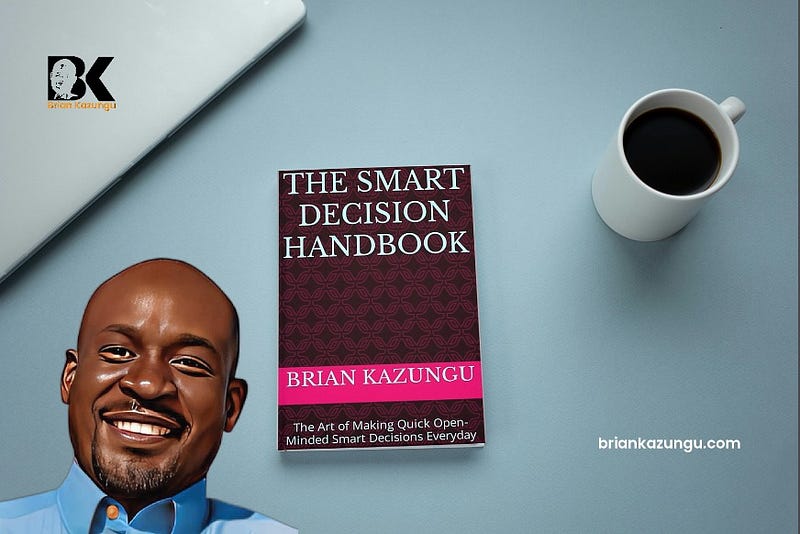
In my consultative engagements with people from different backgrounds and statuses, I have seen that many bad outcomes can be traced back to a decision that was made, and to an action that was taken without a broad consideration of the related consequences of doing something.
I have also observed that a number of bad decisions are actually surprisingly made by highly inspired, well-meaning and yet less informed individuals, and hence I always say — there is no correlation between good intentions and good decisions.

As a result of such an observation, I came up with the following two critical points which I usually share with my clients concerning making smart decisions, whether they are doing an introspection on their past decisions, or they want assistance in making an important decision.
1) Good decisions are a product of exposure to correct information acted upon by an objective and open mind — when you use wrong information, you will make a wrong (bad) decision.
2) You can mean no harm and yet still cause harm — you can have good intentions and still make a bad decision.

In short, since its possible to make bad decisions even though your intentions are good, it means that when you make un-informed decisions, you will unfortunately suffer the consequences bad decisions rather than to enjoy the benefits of having good intentions.
Whether it’s in a personal or corporate space, when you do not have any decision-making tool or model to use in decision making, you are likely to succumb to a bad decision cycle.
A bad decision cycle comes from the fact that consequences of unintended bad decisions result in further bad decisions and bad outcomes.
This cycle of negative outcomes which results from a string of bad decisions can however be broken or gradually reduced through adopting decision-making training initiatives such as the Smart Decision Toolkit adapted from my book, The Smart Decision Handbook.

Before I explain the Smart Decision Toolkit, and show you how to use it, I will give you an overview of some of the most important and widely used decision-models namely: The Eisenhower Matrix, SWOT Analysis and The Pareto Principle.
After explaining the Smart Decision Toolkit, I will show you how it can help you to understand the above-mentioned decision models and many other decision-making resources.
1) The Eisenhower Matrix is a decision model credited to the decision-making approaches of the former United States President, Dwight David Eisenhower who valued importance and urgency in prioritizing tasks.
In summary, I can say that according to this model, tasks are categorized as follows:
i. Urgent and Important — Priority Number 1 — Act on this as soon as you can
ii. Important but not urgent — Priority Number 2 — Schedule to attend to this task later
iii. Urgent but not important — Priority Number 3 — Delegate this to someone else when possible
iv. Not urgent and not important — Priority Number 4 — Keep it mind but don’t bother yourself too much
The main advantage of The Eisenhower Matrix is that it helps you with effective time management since much of people’s bad decisions are caused by the confusion associated with having many things to do and yet not knowing what to start with.
2) SWOT Analysis — Strength, Weaknesses, Opportunities, Threats is a model premised on the evaluation of your competitiveness in the pursuit of corporate or even individual goals.
Most financial institutions such as banks require you to include a SWOT Analysis in your business plan when you are applying for business funding because it helps them to decide better on whether they must give you the money or not.
The SWOT Analysis approach calls for an honest assessment (introspection) of yourself or your enterprise in comparison with others.
In the book, The Art of War, General Sun Tzu says “If you know the enemy and know yourself, you need not fear the result of a hundred battles. If you know yourself but not the enemy, for every victory gained you will also suffer a defeat. If you know neither the enemy nor yourself, you will succumb in every battle.”
3) The Pareto Principle is widely credited to an early 20th century observation by the late Italian economist, Vilfredo Pareto who noticed a correlation between relative input and output.
In short, he observed that some few things have an extra ordinary big impact in real life while on the contrary, there are also so many things that have a combined little significance in the matrix of circumstances.
To simplify the theory, as an example, let’s say, a person has 80% of his conversations with 20% of his contacts in the phone book. This therefore means that 80% of people in your contact list contribute to only a meagre 20% of your conversations.
According to the Pareto Principle, you must know the contributory significance or relevance of something to the bigger picture and then make decisions based on this phenomenon.
The Smart Decision Toolkit on other hand is premised on the Fundamental Congruence Checklist which is basically a set of ten questions that helps you to broadly, objectively and open-mindedly process information about any subject in order for you to understand it better.

A Fundamental Congruence Checklist seeks to answer critical questions that are important for analysing information and reality towards making informed decisions and taking the right action.
It is a multi-versatile decision-making tool that can be used to gauge the relevance, effectiveness, and impact of anything in life through answering the following ten questions:
1) What is this thing? Who is this person?
2) What does he/she/it do and how? — What are the key result areas or objectives and how are they accomplished?
3) Why does he/she/it do so? — Why are those the key result areas, objective, or purpose?
4) What happens if he/she/it does do not anything or does not perform as expected?
5) Where is this thing or person situated in the whole matrix — what position does he/she/it occupy?
6) Why is he/she/it situated there? — Why is he/she/it occupying that space?
7) What happens if he/she/it is completely removed, moved somewhere, misplaced or even altered?
8) Who is in charge of him/her/it and why? — Who makes he/she/it work as planned?
9) How is his/her/its effectiveness assessed? — How do I or other people know if he/she/it is effective or not?
10) What happens if he/she/it is effective or not — What are the related consequences?
By using a Congruence Checklist, you will be able to clearly define the purpose of anything and then determine its relevance and interconnectedness to other things which are dear to you in life before you commit your energy, time, and resources to it.
For example, earlier on, I highlighted that The Eisenhower Matrix places emphasis on importance and urgency in prioritizing tasks, and so, at this point, I must quickly point out that it’s the questions on the Smart Decision Toolkit which helps you to determine whether something is urgent or important.
N.B: You can use the Smart Decision Toolkit to weigh the importance, relevance and urgency of any object or task so that you can effectively utilize The Eisenhower Matrix.
Just like with The Eisenhower Matrix, The Pareto Principle seeks to help you make sound decisions based on the value or importance of the subject matter.

The Pareto Principle shows you that if you are not careful and informed enough, quite often, you can spend much of your time, energy and resources on things that have very little impact on overall results.
As such, in order to avoid misallocation of time, energy and resources, you can use the responses you get from answering questions on your checklist on the Smart Decision Toolkit to come up with the 80/20 Pareto values on the input and outcomes of whatever you are dealing with.
The SWOT Analysis as a decision model helps you to understand that if you want to decide on doing something, you must know positive attributes (strengths and opportunities) which gives you an advantage or which can make you to succeed.
After you have identified these positive attributes (strengths and opportunities), you must then compare them with the negative attributes (weaknesses and threats) which makes it difficult for you to accomplish the set goals.
N.B: It is easy for you to identify your strengths and weaknesses when you try to answer the ten questions on the Congruence Checklist
Without the Smart Decision Toolkit, you may unintentionally misuse The Eisenhower Matrix, SWOT Analysis or Pareto Principle at your own expense by excitedly categorizing those things which you like as more important and urgent than many other things which really deserve to be prioritized.

The Smart Decision Toolkit also helps you to properly adopt and use SWOT Analysis since the answers you provide to the questions on the congruence checklist will reveal or expose the related strengths, weaknesses, opportunities and threats associated with subject matter.
When you don’t ask yourself these ten questions on the Congruence Checklist, you are most likely to make impulsive decisions out of emotions (excitement) and do things that are very costly and regrettable.
The Decision Toolkit’s Congruence Checklist gives you a broader perspective when you want to make a decision on a certain matter especially on issues that which has an effect on your health, time, money and other resources.
A Congruence Checklist helps to reveal the probable consequences of your decision on various other aspects of your life, i.e. the financial, emotional, or spiritual implications of your decisions and actions.
As such, if you want to make an important decision such as starting a business, getting into a partnership, getting married/divorced, quitting your job, voting for a politician, or even buying an asset, you need to ask yourself these ten questions before you make that final decision.

The main advantages of this checklist as a decision tool are that the first three questions focus on clarity on the subject matter by shedding light on the definition, purpose and processes associated with whatever you are dealing with.
The focus on these three issues helps with assurance/confidence on the fact that whoever is making a decision is doing so on a subject that he/she clearly understands.
Question Four (4) on the checklist helps the decision maker to be open-minded enough to understand that despite good intentions, some missions fail, and thus, the mind should be prepared from the beginning to be accountable for such failures and to also come up with Plan B or even C.
The fifth, sixth and seventh questions on the checklist has a ‘Pareto’ effect in that it deals with essence and relevance as a way of evaluating the worthiness of consideration, adoption, and implementation on any subject matter.
These three questions focus on the assessment of importance. When you answer these questions, you will be able to understand if whatever you are dealing with is really worthy your time, money, energy and resources.
Question Eight (8) seeks to identify a person or group of people who are responsible for the implementation of a certain resolution, and also shows us those individuals that are tasked with the mandate of making sure that everything goes as planned (oversight).
The nineth and tenth question seek to address the issue of effectiveness, results and impact, since resolutions that are adopted without clarity on these issues are very costly in terms of time, energy, money and other resources.
The Smart Decision Toolkit ensures that people make openminded decisions and take informed action which they are accountable for and thus promotes the adoption and implementation of good morals and best Corporate Governance practices in both the private and public sector.

Those who make decisions without the use of any decision framework or toolkit, whether in their individual capacity or as a group in an organisation tend to act whimsically (emotionally) than logically at the expense of their stakeholders i.e. family, friends, or shareholders.
It is therefore critically important for every individual or organisation to adopt the Smart Decision Toolkit in their quest for efficiency, effectiveness, accountability and best practices in the pursuit of any objective.
For training and assistance on how to effectively use the Smart Decision Toolkit (Fundamental Congruence Checklist), contact me on — [email protected]
